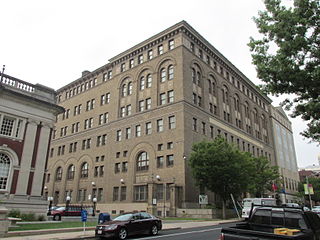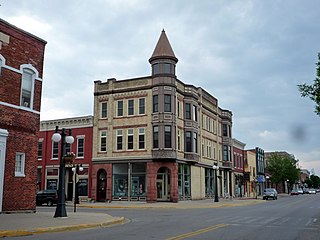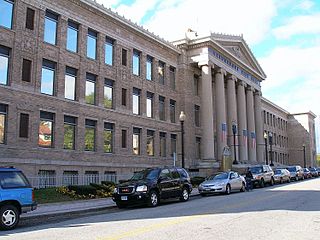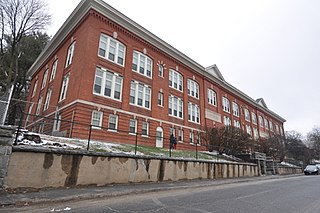
The Main Street Historic District in Danbury, Connecticut, United States, is the oldest section of that city, at its geographical center. It has long been the city's commercial core and downtown. Its 132 buildings, 97 of which are considered contributing properties, include government buildings, churches, commercial establishments and residences, all in a variety of architectural styles from the late 18th century to the early 20th. It is the only major industrial downtown of its size in Connecticut not to have developed around either port facilities or a water power site.

The Downtown Albany Historic District is a 19-block, 66.6-acre (27.0 ha) area of Albany, New York, United States, centered on the junction of State and North and South Pearl streets. It is the oldest settled area of the city, originally planned and settled in the 17th century, and the nucleus of its later development and expansion. In 1980 it was designated a historic district by the city and then listed on the National Register of Historic Places.

The Elm Street Historic District encompasses a collection of architecturally distinguished institutional and residential buildings near the Connecticut State Capitol in Hartford, Connecticut. Located on Capitol Avenue and Trinity and Elm Streets, it includes the city's best concentration of early 20th-century architecture, including Bushnell Memorial Hall and several state office buildings. It was listed on the National Register of Historic Places in 1984.

The Greenwich Avenue Historic District is a historic district representing the commercial and civic historical development of the downtown area of the town of Greenwich, Connecticut. The district was listed on the National Register of Historic Places on August 31, 1989. Included in the district is the Greenwich Municipal Center Historic District, which was listed on the National Register the year before for the classical revival style municipal buildings in the core of Downtown. Most of the commercial buildings in the district fall into three broad styles, reflecting the period in which they were built: Italianate, Georgian Revival, and Commercial style. The district is linear and runs north–south along the entire length of Greenwich Avenue, the main thoroughfare of Downtown Greenwich, between U.S. Route 1 and the New Haven Line railroad tracks.

McLevy Hall is a historic municipal building at 202 State Street in downtown Bridgeport, Connecticut. The building was built in 1854 to house both the City Hall and the Fairfield County Courthouse, and served as Bridgeport City Hall into the 1930s. It was renamed McLevy Hall after Bridgeport mayor Jasper McLevy in 1966. The current city hall on Lyon Terrace was built in 1916, however municipal offices continued to occupy McLevy Hall through the 1970s. It was added to the National Register of Historic Places on September 19, 1977.

The Fairfield County Courthouse, also known as the Court of Common Pleas, is located at 172 Golden Hill Street in downtown Bridgeport, Connecticut. It is also known as Geographical Area (GA) Courthouse No. 2 at Bridgeport. It is a Richardsonian Romanesque brick building built in 1888. It was listed on the National Register of Historic Places in 1982. It still functions as a courthouse where all but the most serious criminal cases are heard.

The Downtown Athens Historic District is a historic area in the Downtown Athens neighborhood of Athens, Georgia. It was listed on the National Register of Historic Places in 1978. Its boundaries were revised twice, in 1984 and 2006, and additional documentation was filed in 2006.

The Bridgeport Downtown South Historic District encompasses the historic elements of the southern part of downtown Bridgeport, Connecticut. It is 27 acres (11 ha) in size, roughly bordered on the east by Main and Middle Streets, on the north by Elm Street, the west by Broad Street, and the south by Cesar Batalla Way. This area includes the highest concentration of buildings developed in the commercial downtown between about 1840 and the 1930s, the period of the city's major growth as a manufacturing center, and includes a diversity of architectural styles representative of that time period. The district was listed on the National Register of Historic Places in 1987.

The Downtown Waterbury Historic District is the core of the city of Waterbury, Connecticut, United States. It is a roughly rectangular area centered on West Main Street and Waterbury Green, the remnant of the original town commons, which has been called "one of the most attractive downtown parks in New England."

The First Street Historic District, also known as the Main Street Historic District, is a commercial historic district in Menominee, Michigan containing over 40 structures spread over a 29 acres (12 ha) area. The district is roughly bounded by Fourth Avenue, the north side of Tenth Avenue, Second Street, and the Green Bay Shoreline; the boundaries are approximately equivalent to what is locally known as the Historic Waterfront Downtown. It was listed on the National Register of Historic Places and designated a Michigan State Historic Site in 1974.

The Hotel Beach, also known historically as the Hotel Barnum, is a historic hotel building at 140 Fairfield Ave. in Bridgeport, Connecticut. It is a thirteen-story Art Deco tower built in 1927 and designed by Thomas, Martin & Kirkpatrick. It is one of the city's outstanding Art Deco buildings, built when the city was at its peak. It was listed on the National Register of Historic Places in 1978. It is a contributing building in the Bridgeport Downtown North Historic District, NRHP-listed in 1987. It is currently a residential apartment building called Barnum House.

The First Baptist Church is a historic church at 126 Washington Avenue in Bridgeport, Connecticut. Built in 1893, it is a distinctive local example of Richardsonian Romanesque architecture, designed by local architect Joseph W. Northrop for a congregation founded in 1837. It was listed on the National Register of Historic Places in 1990.

St. John's Episcopal Church is a historic church at 768 Fairfield Avenue in Bridgeport, Connecticut. Built in 1873 for a congregation founded in the mid-18th century, it is a well-preserved design of James Renwick Jr. and a good example of late 19th-century Gothic Revival architecture. It was listed on the National Register in 1984.

Lambert & Bunnell was a long-lived American architectural firm from Bridgeport, Connecticut, in business from 1860 to 1901. It was established by Edward R. Lambert (1834–1904) and Rufus W. Bunnell (1835–1909).

The Pontiac Commercial Historic District is a primarily commercial historic district located roughly along East Huron and South Saginaw Streets, within loop of Wide Track Drive, in Pontiac, Michigan. The core of the district, within the block bounded by Saginaw, Lawrence, Pike, and Wayne Streets, was originally listed on the National Register of Historic Places in 1984. A boundary increase creating the present boundaries was listed in 1989. The district includes the Eagle Theater and the Grinnell Brothers Music House, also listed on the National Register.

The Golden Hill Historic District encompasses a well-preserved formerly residential area on the northwest fringe of downtown Bridgeport, Connecticut. Located mainly on Lyon Terrace, Gold Hill Street, and Congress Street, the district includes 11 formerly residential buildings now mainly in commercial use, which were built between about 1890 and 1930. It also includes Bridgeport City Hall, and the Golden Hill United Methodist Church. The district was listed on the National Register of Historic Places in 1987.

The Webster School is a historic former school buildings at Easton Avenue and Aetna Street in Waterbury, Connecticut. Built in 1898 to a design by the noted local architect Wilfred E. Griggs, it is a good example of Classical Revival architecture, and an emblem of the city's rapid growth at the turn of the 20th century. It was closed in 1977, and was listed on the National Register of Historic Places in 1982. The building has been converted into housing.

The Division Street Historic District encompasses one of the best-preserved 19th-century residential areas of Bridgeport, Connecticut. Now separated from downtown Bridgeport by the Connecticut Route 25 highway, the area includes a cross-section of 19th-century architectural styles, as well as a diversity of sophistication, from working-class accommodations to high-style Victorian mansions. The district was listed on the National Register of Historic Places in 1982.

The Fairfield County Jail was a historic penal facility at 1106 North Avenue in Bridgeport, Connecticut. Built in 1870-71, it served as a jail and prison for over a century, and was the state's oldest such facility in active use at the time of its listing on the National Register of Historic Places in 1985. It has subsequently been demolished; the property is now home to the more modern facilities of the Bridgeport Correctional Center.

The Railroad Avenue Industrial District is a historic industrial area on the west side of Bridgeport, Connecticut. It extended along both sides of Railroad Avenue between Fairfield Street and Wordin Avenue, and was roughly bounded on the north by State Street and the south by Cherry Avenue. It was listed on the National Register of Historic Places in 1985, then featuring multiple industrial complexes dating to the late 19th and early 20th centuries. Since then, most of these complexes have been demolished as part of urban renewal, leaving only a handful of buildings south of Railroad Avenue.






















